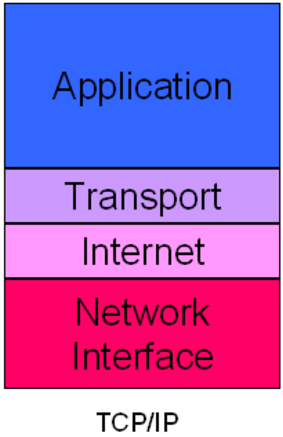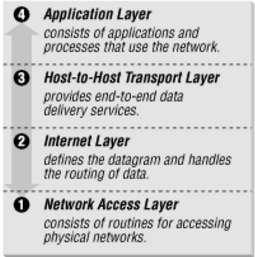The Open System Interconnect (OSI) Model
Layer 7— The application layer: This is the layer at which communication partners are identified, quality of service is identified, user authentication and privacy are considered, and any constraints on data syntax are identified. (This layer is not the application itself, although some applications may perform application layer functions). It represents the services that directly support applications such as software for file transfers, database access, email, and network games.
Layer 6—The presentation layer: This is a layer, usually part of an operating system, that converts incoming and outgoing data from one presentation format to another (for example, from a text stream into a popup window with the newly arrived text). This layer also manages security issues by providing services such as data encryption and compression. It’s sometimes called the syntax layer.
Layer 5—The session layer: This layer allows applications on different computers to establish, use, and end a session/connection. This layer establishes dialog control between the two computers in a session, regulating which side transmits, and when and how long it transmits.
Layer 4—The transport layer: This layer handles error recognition and recovery, manages the end-to-end control (for example, determining whether all packets have arrived) and error-checking. It ensures complete data transfer.
Layer 3—The network layer: This layer handles the routing of the data, addresses messages and translates logical addresses and names into physical addresses. It also determines the route from the source to the destination computer and manages traffic problems (flow control), such as switching, routing, and controlling the congestion of data packets.
Layer 2—The data-link layer: This layer package raw bit from the Physical layer into frames (logical, structures packets for data). It is responsible for transferring frames from one computer to another, without errors. After sending a frame, it waits for an acknowledgment from the receiving computer.
Layer 1—The physical layer: This layer transmits bits from one computer to another and regulates the transmission of a stream of bits over a physical medium. This layer defines how the cable is attached to the network adapter and what transmission technique is used to send data over the cable.
Protocol
TCP/IP Model
1. Application layer
This is the top layer of TCP/IP protocol suite. This layer includes applications or processes that use transport layer protocols to deliver the data to destination computers. Some of the popular application layer protocols are :
- HTTP (Hypertext transfer protocol)
- FTP (File transfer protocol)
- SMTP (Simple mail transfer protocol)
- SNMP (Simple network management protocol) etc
2. Transport Layer
This layer provides backbone to data flow between two hosts. This layer receives data from the application layer above it. There are many protocols that work at this layer but the two most commonly used protocols at transport layer are TCP and UDP.
3. Network Layer
This layer is also known as Internet layer. The main purpose of this layer is to organize or handle the movement of data on network. By movement of data, we generally mean routing of data over the network. The main protocol used at this layer is IP. While ICMP(used by popular ‘ping’ command) and IGMP are also used at this layer.
4. Data Link Layer
This layer is also known as network interface layer. This layer normally consists of device drivers in the OS and the network interface card attached to the system. Both the device drivers and the network interface card take care of the communication details with the media being used to transfer the data over the network. In most of the cases, this media is in the form of cables. Some of the famous protocols that are used at this layer include ARP(Address resolution protocol), PPP(Point to point protocol) etc.
Comparison of OSI Reference Model and TCP/IP Reference Model
Following are some major differences between OSI Reference Model and TCP/IP Reference Model, with diagrammatic comparison below.
| OSI(Open System Interconnection) | TCP/IP(Transmission Control Protocol / Internet Protocol) |
|---|---|
| 1. OSI provides layer functioning and also defines functions of all the layers. | 1. TCP/IP model is more based on protocols and protocols are not flexible with other layers. |
| 2. In OSI model the transport layer guarantees the delivery of packets | 2. In TCP/IP model the transport layer does not guarantees delivery of packets. |
| 3. Follows horizontal approach | 3. Follows vertical approach. |
| 4. OSI model has a separate presentation layer | 4. TCP/IP does not have a separate presentation layer |
| 5. OSI is a general model. | 5. TCP/IP model cannot be used in any other application. |
| 6. Network layer of OSI model provide both connection oriented and connectionless service. | 6. The Network layer in TCP/IP model provides connectionless service. |
| 7. OSI model has a problem of fitting the protocols in the model | 7. TCP/IP model does not fit any protocol |
| 8. Protocols are hidden in OSI model and are easily replaced as the technology changes. | 8. In TCP/IP replacing protocol is not easy. |
| 9. OSI model defines services, interfaces and protocols very clearly and makes clear distinction between them. | 9. In TCP/IP it is not clearly separated its services, interfaces and protocols. |
| 10. It has 7 layers | 10. It has 4 layers |
Referrences:
- http://www.cisco1900router.com/what-is-ios-model-the-overall-explanation-of-ios-7-layers.html
- http://www.thegeekstuff.com/2011/11/tcp-ip-fundamentals/
- http://www.studytonight.com/computer-networks/comparison-osi-tcp-model






No comments:
Post a Comment